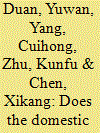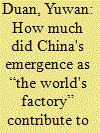| Srl | Item |
| 1 |
ID:
114793


|
|
|
|
|
| Publication |
2012.
|
| Summary/Abstract |
Since 2001, the exports of foreign-invested enterprises (FIEs) have accounted for more than 50 percent of China's total exports. As foreign capital occupies a high proportion of the total capital of FIEs, most FIEs' capital gains are foreign factor income. Although these gains are calculated as a part of China's GDP, they do not belong to China's national income. To determine the real contribution of exports to China's welfare, the present paper analyses the impact of exports on China's national income using a non-competitive input-output model capturing processing trade. The results show that every US$1000 of China's exports generates US$506.8 of national income. The real contribution of exports to China's welfare is much smaller than what we expected. This suggests that China should endeavor to improve the gains from international markets or find another engine to maintain its economic growth.
|
|
|
|
|
|
|
|
|
|
|
|
|
|
|
|
| 2 |
ID:
182780


|
|
|
|
|
| Summary/Abstract |
Over time, China upgraded its capabilities to such an extent that it requires less imported materials, components, and services to maintain its central role in the global production network. Consequently, the domestic value added content of its exports has increased over time. Still, value added includes profits, which are partly earned by foreign capital owners, many of whom have set up operations in export processing zones. Such profits can be repatriated, and do not directly enhance the living standards in China. This paper will focus on the extent to which China's exporting activities have contributed to its Gross National Income (GNI), which is a better indicator of economy-wide living standards than GDP. Our results, based on input-output analysis, show that the increase in the share of Chinese GNI of a yuan of Chinese exports from 2002 to 2007 was modest, despite a marked growth of Chinese GDP contained in such a yuan of exports. From 2007 to 2017, however, the continued increase of domestic value added per yuan of exports did actually translate into considerably higher contributions of exports to GNI. Decomposition analyses show that changes in the commodity composition of China's export bundle and changes in the shares of national income in value added were the main cause of the different patterns before and after the financial crisis.
|
|
|
|
|
|
|
|
|
|
|
|
|
|
|
|